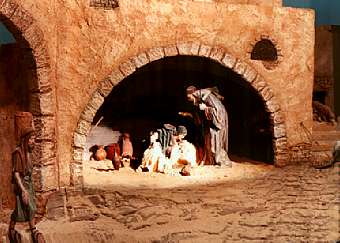|
|
|
|
While most places in Spain celebrate with the usual Christmas festivities, in Granada and Jaen there is one tradition, not at all common elsewhere. Named Hogueras (bonfires), this custom began prior to the arrival of Christianity and is the observance of the Winter Solstice. Wood fires are built and people jump over them in the belief that they will be protected against illness.
As in many other European nations, Christmas markets are scattered among villages and cities with booths filled with fruits such as pomegranates of Andalusia, Valencia oranges, and Arragonese apples along with walnuts and chestnuts from Gallicia. There are also flowers, marzipan candies, baked goods, candles, decorations and hand-crafted Christmas gifts. Choirs entertain at the markets and the scents and sounds fill the air during the Advent season. Church bells ring out on Noche Buena (the "Good Night" or Christmas Eve) calling everyone to Misa de Gallo (Mass of the Rooster). Many believe that the most beautiful of these candlelight services is held at the mountain monastery at Montserrat. The boy's choir at the monastery has been described as performing the Mass in "one pure voice." At Labastida, shepherds enter the church bearing a lamb, and a shepherdess carries a representation of the Christ Child.  After Mass, people return to their homes for a feast. In some areas it often features a main course of Pavo or turkey, usually stuffed with truffles, but along the coast you may find cod or red snapper. Following the meal, families usually gather around the Christmas tree to sing Spain's famous carols, called villancios or goigs. The celebration continues until dawn as expressed in an old Spanish proverb: Esta noche es Noche-Buena, Y no es noche de dormir. (This is the Good Night, therefore it is not meant for sleep.) Christmas Day sees more festive eating, either of leftovers from the previous night's meal or another family feast. Some attend another church service. One custom peculiar to Spain is that of "swinging." Swings are set up throughout the courtyards and young people swing to the accompaniment of songs and laughter. Some families have adopted the American Santa Claus,or Papa Noel as he is known locally, as the gift-bringer on Christmas Eve, but most continue to wait until January 6th for the traditional visit of the Three Kings.
In some towns the Magi arrive in a boat from across the sea while in others they come by helicopter. You may also see them astride horses or riding on parade floats. They visit hospitals, orphanages and homes for the elderly, as they pass through Spain on their way to Bethlehem. The Spanish children have a great fondness for the Three Kings, especially Balthazar. |
Please sign the Guest Book